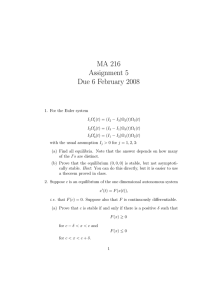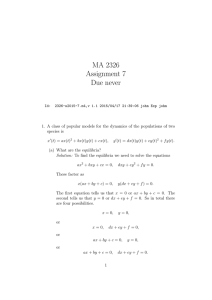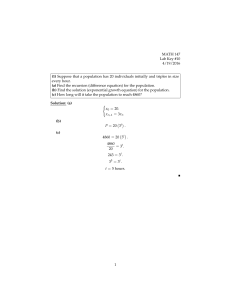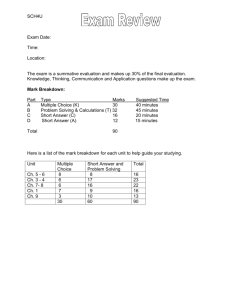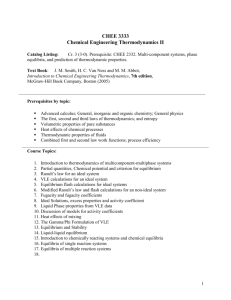MA 216 Assignment 5 Due 6 February 2008
advertisement
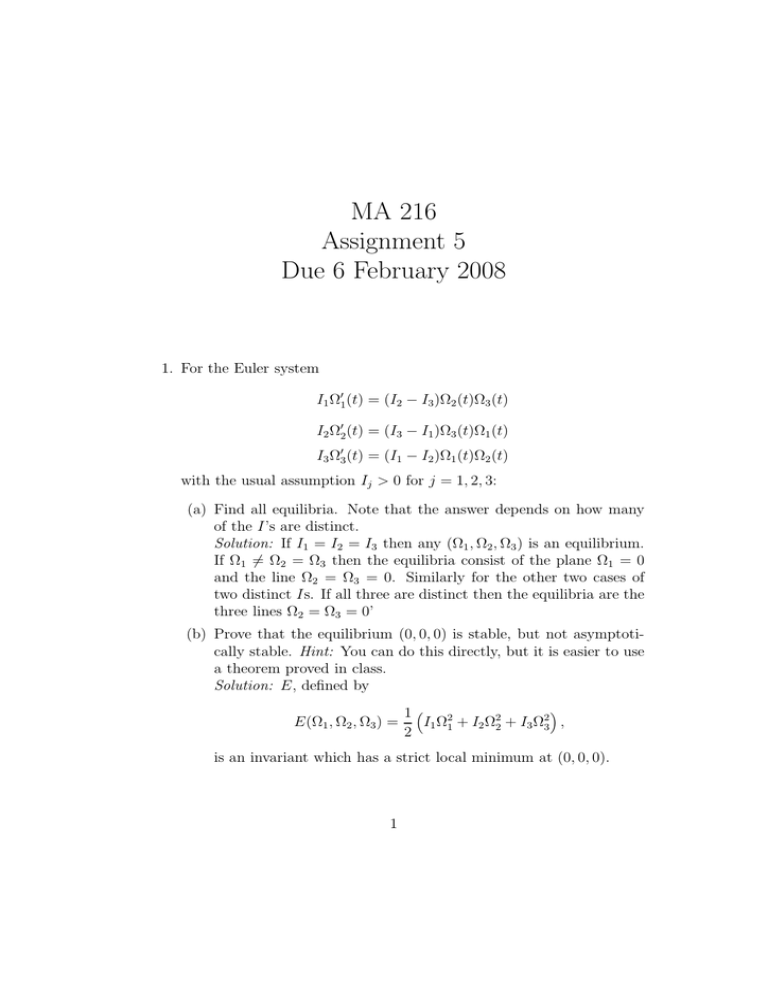
MA 216 Assignment 5 Due 6 February 2008 1. For the Euler system I1 Ω′1 (t) = (I2 − I3 )Ω2 (t)Ω3 (t) I2 Ω′2 (t) = (I3 − I1 )Ω3 (t)Ω1 (t) I3 Ω′3 (t) = (I1 − I2 )Ω1 (t)Ω2 (t) with the usual assumption Ij > 0 for j = 1, 2, 3: (a) Find all equilibria. Note that the answer depends on how many of the I’s are distinct. Solution: If I1 = I2 = I3 then any (Ω1 , Ω2 , Ω3 ) is an equilibrium. If Ω1 6= Ω2 = Ω3 then the equilibria consist of the plane Ω1 = 0 and the line Ω2 = Ω3 = 0. Similarly for the other two cases of two distinct Is. If all three are distinct then the equilibria are the three lines Ω2 = Ω3 = 0’ (b) Prove that the equilibrium (0, 0, 0) is stable, but not asymptotically stable. Hint: You can do this directly, but it is easier to use a theorem proved in class. Solution: E, defined by E(Ω1 , Ω2 , Ω3 ) = 1 I1 Ω21 + I2 Ω22 + I3 Ω23 , 2 is an invariant which has a strict local minimum at (0, 0, 0). 1 2. Suppose c is an equilibrium of the one dimensional autonomous system x′ (t) = F (x(t)), i.e. that F (c) = 0. Suppose also that F is continuously differentiable. (a) Prove that c is stable if there is a positive δ such that F (x) ≥ 0 for c − δ < x < c and F (x) ≤ 0 for c < x < c + δ. Solution: It’s helpful to start with a lemma which says that if x1 and x2 are solutions with x1 (s) < x2 (s) for some s then x1 (t) < x2 (t) for all t. In other words the graphs of solutions never cross. Suppose on the contrary that x1 (t) ≥ x2 (t) somewhere. Then there is, by the intermediate value theorem, a τ in between s and t such that x1 (τ ) = x2 (τ ). Then x1 and x2 are both solutions to the initial value problem x′ (t) = F (x(t) x(τ ) = x1 (τ ) and hence, by the uniqueness part of the existence and uniqueness theorem, x1 = x2 and x1 (s) = x2 (s), contrary to our hypotheses. Thus there is no such t for which x1 (t) ≥ x2 (t) and x1 (t) < x2 (t), as claimed. As a special cases of the lemma, if x(0) > c then x(t) > c for all t > 0 and if x(0) < c then x(0) < c for all t > 0. From this, and 2 the assumptions about the sign of F ′ it follows that x is increasing for all t > 0 if c < x(0) < c + δ and is decreasing for all t > 0 if c < x(0) < c + δ. Therefore |x(t) − c| < |x(0) − c| for all t whenever |x(0) − c| < δ. From this stability follows immediately. (b) Prove that c is asymptotically stable if and only if there is a positive δ such that F (x) > 0 for c − δ < x < c and F (x) < 0 for c < x < c + δ. Solution: The if part is proved as follows. Suppose that c < x(0) > c + δ. The case c − δ < x(0) < c will be the same except for some signs. From the assumptions on F we know that x is decreasing Since it is bounded from below by c the limit ξ = lim x(t) t→+∞ must exist. By the continuity of F , lim x(t) = ξ = lim F (x(t)) = F (ξ) t→+∞ t→+∞ exists as well. Any limit other than 0 is incompatible with the existence of limt→+∞ x(t) 3. Find a strict Lyapunov function for the equilibrium (0, 0) of the system x′1 (t) = −x1 (t) x′2 (t) = −x1 (t) − x2 (t) Hint: From lecture you know that there is a strict Lyapunov function which is a quadratic polynomial. In fact there are many and you should be able to find one by trial and error. Solution: There are many possible choices. For example, V (x1 , x2 ) = x21 + x22 3 works with ∂V ∂V F1 + F2 = −2x21 − 2x1 x2 − 2x22 ≤ −x21 − x22 = −1V (x1 , x2 ). ∂x1 ∂x2 4. For equilibrium θ = 0 of the damped pendulum lθ′′ (t) + 2γθ′ (t) + g sin(θ(t)) = 0 find a strict Lyapunov function assuming that l, γ and g are all positive. Hint: From lecture you know that there should be a quadratic polynomial which is a strict Lyapunov function for both the original nonlinear equation and its linearisation. Solution: The linearised problem is lθ′′ (t) + 2γθ′ (t) + gθ(t) = 0 In the underdamped case lg > γ 2 we can use the same choice as made in lecture for the spring, making the necessary changes in the names of the variables and parameters. g l ′ 2 (θ ) + γθθ′ + θ2 . 2 2 This is not the only choice which works. For the overdamped and critically damped cases almost anything which is positive definite will work. The choice above will not, because it is not positive definite. 5. The restricted three body problem in Celestial Mechanics is that of the motion of three bodies in a plane subject to Newtonian gravitational forces, subject to the additional restrictions that (1) the third body is of neglibible mass and (2) the first two bodies are in uniform circular motion. The relevant system of ordinary differential equations is x′ (t) = ωy + u y ′ (t) = −ωx + v Gm1 (x−ξ1 ) u′ (t) = − [(x−ξ 2 2 3/2 − 1 ) +y ] Gm1 y ′ v (t) = − [(x−ξ1 )2 +y2 ]3/2 − Gm2 (x+ξ2 ) [(x+ξ2 )2 +y 2 ]3/2 Gm2 y [(x+ξ2 )2 +y 2 ]3/2 + ωv − ωu The variables x and y give the position and u and v the velocity of the thrid (massless) body with respect to axes rotating with the first two 4 (massive) bodies. m1 and m2 are masses of the first two bodies and ξ1 and ξ2 their distances to the origin, which is located at the centre of mass of the system. G is Newtonprimes gravitational constant and ω is the angular velocity of the two massive bodies. These numbers are related by G(m1 + m2 ) ω2 = (ξ1 + ξ2 )3 and m1 ξ1 = m2 ξ2 . You can now, if you wish, forget everything in this paragraph except the equations. (a) Lagrange showed the only equilibria of the system are i. All three masses are collinear, i.e. y = 0. There are several possible values of x. All of these are easily seen to be unstable by consideration of the eigenvalues of the the corresponding linearised problems. ii. The three masses occupy the three points of an equilateral triangle, i.e. x= ξ1 − ξ2 2 y=± ξ1 + ξ2 √ 3. 2 Verify Lagrange’s claim that the equilateral triangle configurations are equilibria. Solution: Substitute x= ξ1 − ξ2 2 y=± ξ1 + ξ2 √ 3 u = −ωy 2 v = ωx and simplify. (b) Verify that the function H(x, y, u, v) = u2 + v 2 Gm1 Gm2 −ωxv+ωyu− q −q 2 (x − ξ1 )2 + y 2 (x + ξ2 )2 + y 2 5 is an invariant. Hint: The system can be written in the simpler form ∂H x′ (t) = (x(t), y(t), u(t), v(t)) ∂u ∂H (x(t), y(t), u(t), v(t)) y ′(t) = ∂v ∂H u′ (t) = − (x(t), y(t), u(t), v(t)) ∂x ∂H v ′ (t) = − (x(t), y(t), u(t), v(t)) ∂y Solution: Having checked the claim from the hint, dH ∂H ′ ∂H ′ ∂H ′ ∂H ′ = x (t) + y (t) + u (t) + v (t) dt ∂x ∂y ∂u ∂v ∂H ∂H ∂H ∂H ∂H ∂H ∂H ∂H + − − = 0. = ∂x ∂u ∂y ∂v ∂u ∂x ∂v ∂y (c) Show by means of the second derivative test that the function H has a strict local minimum at the equilateral triangle configurations if (m1 + m2 )2 > 27 m1 m2 and hence, by the theorem from lecture about invariants and stability, these equilibria are stable, but not strictly stable. Solution: The statement about the local minimum is false.1 Sorry about that. The Hessian, i.e. the matrix of second partial derivatives, is 2 ∂ V /∂x2 ∂ 2 V /∂x∂y 0 −ω ∂ 2 V /∂x∂y ∂ 2 V /∂y 2 ω 0 0 ω 1 0 −ω 0 0 1 where V (x, y) = − q Gm1 Gm2 −q . (x − ξ1 )2 + y 2 (x + ξ2 )2 + y 2 1 The conclusion you were supposed to derive, that these equilibria are stable but not strictly stable, is still true, but unfortunately it cannot be proved by this method. 6 Evaluating the second derivatives at the equilibrium gives, 1 2 ω √4 3 3 µω 2 4 0 −ω √ 3 3 µω 2 4 − 54 ω 2 ω 0 0 ω 1 0 −ω 0 0 1 Unfortunately this is never positive definite. (d) Show that if (m1 + m2 )2 < 27. m1 m2 then the linearisation about the equilateral triangle configurations has at least one, in fact two, eigenvalues with positive real part, and hence is unstable. Solution: The linearisation of the system ∂H (x(t), y(t), u(t), v(t)) ∂u ∂H (x(t), y(t), u(t), v(t)) y ′(t) = ∂v ∂H (x(t), y(t), u(t), v(t)) u′ (t) = − ∂x ∂H (x(t), y(t), u(t), v(t)) v ′ (t) = − ∂y x′ (t) = has coefficient matrix ∂ 2 H/∂x∂u ∂ 2 H/∂x∂v −∂ 2 H/∂x2 −∂ 2 H/∂x∂y or ∂ 2 H/∂y∂u ∂ 2 H/∂u2 ∂ 2 H/∂v∂u ∂ 2 H/∂y∂v ∂ 2 H/∂u∂v ∂ 2 H/∂v 2 2 2 2 −∂ H/∂y∂x −∂ H/∂u∂x −∂ H/∂v∂x −∂ 2 H/∂y 2 −∂ 2 H/∂u∂y −∂ 2 H/∂v∂y 0 −ω 1 − 4 ω2 √ − 3 4 3 µω 2 ω √0 − 3 4 3 µω 2 5 2 ω 4 The characteristic polynomial is λ4 + ω 2 λ2 + 1 0 0 −ω 0 1 ω 0 27 27m1 m2 /(m1 + m2 )2 4 (1 − µ2 )ω 4 = λ4 + ω 2 λ2 + ω . 16 4 7 Completing the square, we get 1 λ − ω2 2 2 2 27m1 m2 − 1− (m1 + m2 )2 ! ω4 . 4 The roots of the characteristic equation are therefore v u u ω2 ±t− s ω2 27m1 m2 ± 1− 2 2 (m1 + m2 )2 2 2) If (mm1 +m > 27 then the inner square root is imaginary and there 1 m2 are four complex roots, two of which have positive real parts. 8
